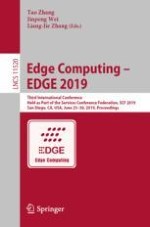2019 | Buch
Edge Computing – EDGE 2019
Third International Conference, Held as Part of the Services Conference Federation, SCF 2019, San Diego, CA, USA, June 25–30, 2019, Proceedings
herausgegeben von: Tao Zhang, Dr. Jinpeng Wei, Liang-Jie Zhang
Verlag: Springer International Publishing
Buchreihe : Lecture Notes in Computer Science
